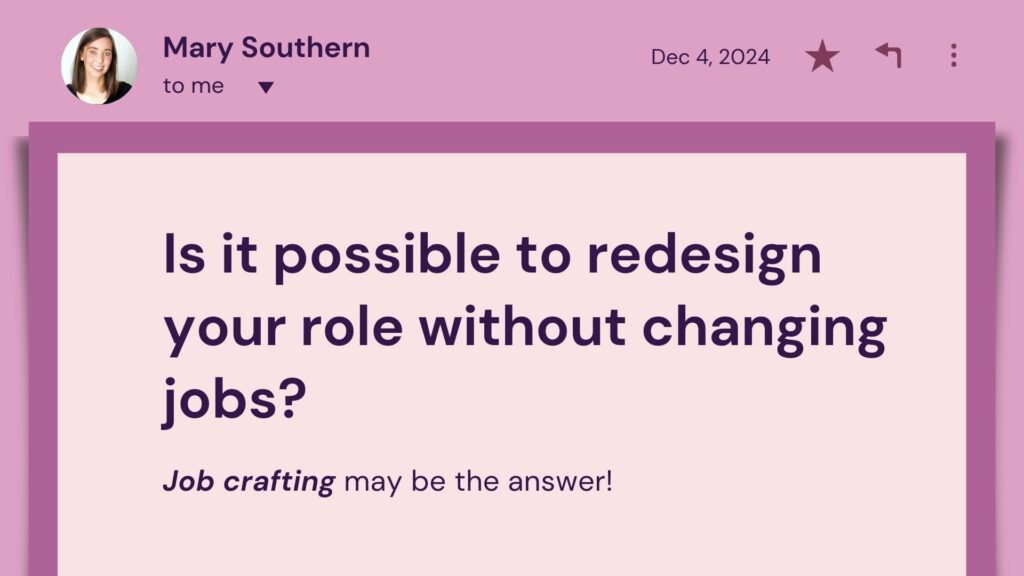
Introduction
Feeling unfulfilled or stagnant in your current job doesn’t always mean it’s time to dust off your resume and start job hunting. Job crafting offers a proactive approach to redesigning your role to better align with your strengths, passions, and career aspirations—all without changing employers. This concept empowers you to reshape your work experience, leading to increased satisfaction and engagement.
What is Job Crafting?
Job crafting is the process of employees making physical and cognitive changes in the tasks or relationships associated with their job. It involves taking initiative to customize your role, enhancing both your performance and job satisfaction.
The Three Forms of Job Crafting
- Task Crafting
- Definition: Altering the type, scope, or number of tasks you perform.
- Examples:
- Taking on new projects that interest you.
- Streamlining or automating routine tasks to focus on more meaningful work.
- Proposing innovative solutions to existing problems.
- Relational Crafting
- Definition: Changing the nature or extent of your interactions with others.
- Examples:
- Building relationships with different departments.
- Seeking mentorship or becoming a mentor.
- Collaborating with colleagues who share your professional interests.
- Cognitive Crafting
- Definition: Changing the way you perceive your tasks and their meaning.
- Examples:
- Reframing a tedious task as essential to the bigger picture.
- Aligning your work with personal values or goals.
- Finding new purpose in your role by focusing on the impact of your work.
Benefits of Job Crafting
- Increased Job Satisfaction: Aligning work with personal interests boosts morale.
- Enhanced Performance: Engaged employees are more productive and creative.
- Career Development: Expanding your role can open up new opportunities for advancement.
- Reduced Burnout: Focusing on fulfilling tasks can alleviate stress and fatigue.
How to Start Job Crafting
- Self-Assessment
- Identify Strengths: What are you good at? What tasks energize you?
- Determine Passions: What aspects of your job do you enjoy the most?
- Recognize Areas for Growth: Where do you want to develop new skills?
- Analyze Your Current Role
- List Tasks: Document your daily responsibilities.
- Assess Alignment: Compare your tasks with your strengths and passions.
- Identify Gaps: Note areas where adjustments could improve satisfaction.
- Develop a Crafting Plan
- Set Goals: Define what you want to achieve through job crafting.
- Brainstorm Changes: Think of specific ways to alter tasks, relationships, or perceptions.
- Prioritize Actions: Focus on changes that are feasible and have the most impact.
- Communicate with Management
- Prepare a Proposal: Outline how your changes benefit both you and the organization.
- Schedule a Meeting: Discuss your ideas with your supervisor.
- Seek Feedback: Be open to suggestions and collaborate on implementing changes.
- Implement and Adjust
- Take Action: Begin making the agreed-upon changes.
- Monitor Progress: Regularly assess how the changes are affecting your satisfaction and performance.
- Be Flexible: Adjust your approach as needed based on feedback and results.
Overcoming Potential Challenges
- Resistance from Management: Emphasize how job crafting aligns with company goals and can improve overall performance.
- Workload Balance: Ensure that taking on new tasks doesn’t lead to overload; consider delegating or streamlining other duties.
- Team Dynamics: Communicate openly with colleagues to avoid misunderstandings and ensure collaborative support.
Real-World Examples
- Administrative Assistant to Project Coordinator: By expressing interest in project management, an assistant begins coordinating small projects, eventually transitioning into a formal project coordinator role.
- Salesperson Enhancing Customer Relations: A salesperson focuses on building deeper relationships with clients, leading to increased sales and customer loyalty.
- Engineer Incorporating Sustainability: An engineer passionate about the environment integrates sustainable practices into projects, benefiting both the company and personal fulfillment.
Conclusion
Job crafting is a powerful tool that puts you in the driver’s seat of your career satisfaction. By proactively reshaping your role to better fit your strengths and passions, you can find renewed purpose and engagement in your work. It’s about making your job work for you, not just working for your job.
Ready to update your resume and optimize your LinkedIn profile?
Reach out today! www.resumeassassin.com or mary@resumeassassin.com
Connect on LinkedIn: www.linkedin.com/in/mary-southern
Schedule a 15 Minute Call: https://calendly.com/resumeassassin/meet
